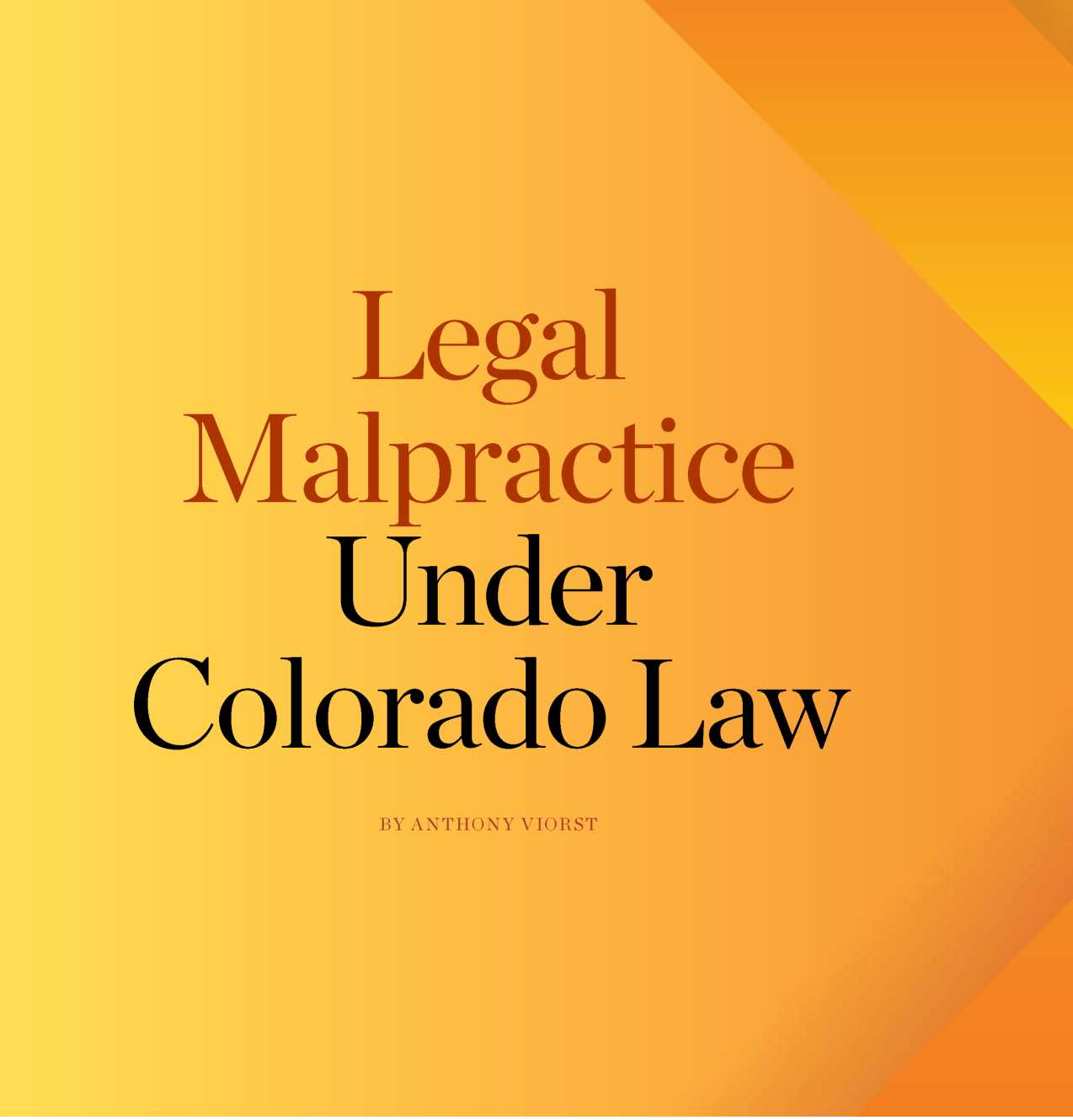Legal Malpractice Under Colorado Law
| Jurisdiction | Colorado,United States |
| Citation | Vol. 52 No. 3 Pg. 26 |
| Pages | 26 |
| Publication year | 2023 |
FEATURE | THE CIVIL LITIGATOR


This article discusses the various grounds, elements, and defenses for legal malpractice cases in Colorado.
In many ways, Colorado legal malpractice cases are just like traditional negligence cases. Depending on the basis for the malpractice claim, however, there may be some important differences, such as the requirement for expert witnesses, the standard for proving causation, and the damages available. In addition to the nuances of legal malpractice cases based on negligence, this article outlines malpractice claims based on breach of fiduciary duty and breach of contract and highlights how each is distinct from a negligence claim.
Attorney-Client Relationship Required
To prevail on a claim of legal malpractice, the complaining party must prove they had an attorney-client relationship with the lawyer.[1]The best way to show the existence of an attorney-client relationship is with a fee agreement, but it is not the only way. The test for whether an attorney-client relationship exists is subjective. It may be inferred from the parties' conduct or the client's perception of the relationship.[2]Once an attorney-client relationship has been established, an attorney cannot make an agreement with the client that prospectively limits the lawyer's liability, except under very narrow circumstances.[3] Although Colorado attorneys are not obligated to carry professional malpractice insurance, all attorneys in private practice must disclose to the bar whether they carry such insurance.[4]
Under the strict privity rule, an attorney's obligation is typically limited to their client and does not extend to any third party.[5] Thus, the Colorado courts have dismissed legal malpractice claims under a third-party beneficiary theory.[6] Although the absence of an attorney-client relationship does not preclude an aggrieved party from successfully pursuing a legal action, the claims available to a non-client are usually limited to negligent misrepresentation, fraud, and malicious or tortious acts.[7]
Legal malpractice cases are not assignable to third parties because they involve matters of personal trust and personal service, and permitting the transfer of such claims would undermine the attorney-client relationship.[8]
Legal Malpractice Case Based on Negligence
Under well-settled Colorado law, in a legal malpractice case involving the mishandling of an underlying claim, as in other types of negligence cases, the plaintiff must prove that (1) the lawyer owed a duty of care to the plaintiff, (2) the lawyer breached the duty of care, (3) the breach proximately caused an injury to the plaintiff, and (4) damages resulted.[9] In addition, as discussed below, in a legal malpractice case based on a lost judgment or other monetary harm in an underlying matter, the plaintiff must also prove collectibility, an element that is unique to legal malpractice cases.
Duty and Breach
To determine whether an attorney's conduct is negligent, a fact finder must compare that conduct with what an attorney, having and using that knowledge and skill of attorneys practicing law at the same time, would or would not have done under the same or similar circumstances.[10] Except in clear and palpable cases, such as failing to file a lawsuit within the statute of limitations, expert testimony is necessary to establish the standards of acceptable professional conduct.[11]
Although the Colorado Rules of Professional Conduct explicitly state that a rule violation alone should neither give rise to a cause of action against a lawyer nor create a presumption of a breach of legal duty, in appropriate cases, a lawyer's violation of a rule may be evidence that the lawyer breached the applicable standard of conduct.[12]
Causation
Four aspects of causation in legal malpractice cases based on negligence are discussed below.
Lost judgment or other monetary harm in an underlying matter. In legal malpractice cases predicated on a lost judgment or other monetary harm in an underlying matter, causation is proved by presenting evidence in support of the underlying claim, also known as the "case within a case."[13] When an attorney commits legal malpractice that prevents the underlying case from reaching a fair judicial resolution-because the case was either not timely filed or not litigated in a competent manner-the merits of the underlying claim must be proved by a preponderance of the evidence. In legal malpractice cases predicated upon an unfavorable business transaction, a plaintiff must show that they would have obtained a more favorable result in the underlying transaction but for the attorney's negligence.[14]
When an attorney commits legal malpractice, but the case nonetheless settles, the aggrieved client can still bring a legal malpractice case[15]if they can show that the attorney's negligence effectively forced a settlement.[16] Under such circumstances, "damages are calculated based on the difference between the actual settlement amount and . . . what the result should have been through judicial resolution."[17] Of course, the decision whether to accept a settlement offer in a litigated case is ultimately the subjective decision of the particular client.[18] However, in legal malpractice cases involving a settlement of the underlying case, the fact finder must determine "what a reasonable client would have done under the particular circumstances confronting the plaintiff."[19]
Lost legal fees and costs directly related to attorney malpractice. The "case within a case" need not be proved in every legal malpractice case and particularly not when the only damages alleged are legal fees and costs directly related to the attorney malpractice.[20] When the injury claimed is not based on the success of the underlying litigation or business transaction, the case-within-a-case methodology does
The Colorado Supreme Court has held that to prove causation in a legal malpractice case, the plaintiff "˜must demonstrate that the claim underlying the malpractice action should have been successful if the attorney had acted in accordance with his or her duties.'
not apply.[21] To prove causation in cases of this nature, the claimant need only prove financial loss or harm caused by their attorney's negligent acts or omissions.[22] Thus, in Boulders at Escalante, LLC v. Otten Johnson Robinson Neff & Ragonetti,[23] the plaintiff-client sought to recover the attorney fees and costs incurred in pursuing counterclaims against a general contractor that would not have been pursued "had Law Firm correctly advised it that there was no insurance coverage to pay a judgment against the contractor on the counterclaims."[24]Even though this legal malpractice action was premised upon the theory that the underlying claim was clearly lacking in merit, the Colorado Court of Appeals held that such damages were recoverable because the attorney's negligence caused the client to pursue the meritless claim.[25]
The objective standard. The Colorado Supreme Court has held that to prove causation in a legal malpractice case, the plaintiff "must demonstrate that the claim underlying the malpractice action should have been successful if the attorney had acted in accordance with his or her duties."[26]
Although the Colorado appellate courts have never defined the "should have been successful" standard, the US District Court for the District Court of Colorado has explained that a trial-within-a-trial should determine "what the result should have been (an objective standard), not what the result would have been by a particular judge or jury (a subjective standard)."[27] This is because, as a general rule, the decision maker's mental processes are inadmissible.[28] Further, the case-within-a-case inquiry focuses on what the proper result should have been absent negligence, not what a particular judge or jury would have decided.[29]
Colorado courts have cited Bebo Construction v. Mattox & O'Brien, PC. multiple times for the proposition that a legal malpractice plaintiff must prove that they "should have been successful" if not for the attorney mal-practice.[30] However, our courts have also cited Bebo Construction for the proposition that a legal malpractice plaintiff must show that they "would have been successful" if not for the attorney malpractice.[31] Although Colorado courts have employed both phrases, "should have" and "would have," the standard in legal malpractice cases appears to remain an objective one.[32] This standard is embodied in the Colorado model j ury instruction, which explicitly states that in legal malpractice cases involving an underlying matter or case-within-a-case, the plaintiff must prove that they "should have prevailed in the underlying case."[33]
Division of labor between judge and jury. Although no Colorado appellate court has expressly described the division of labor between judge and jury in legal malpractice cases, the US District Court for the District of Colorado has held that when a malpractice case is based on proving that the underlying action should have been successful, the "guiding principle in identifying issues of law and fact is to utilize the same classifications as should have been applied in the underlying case."[34]That is, the jury makes findings offact related to liability and damages and the judge determines issues of law.[35] As a practical matter, in a legal malpractice case where an attorney failed to file an appropriate motion or a timely appeal in the underlying case, the trial judge must determine whether the motion or appeal should have been successful.[36]
Damages
Certainty as to the full amount of financial harm is not required for a legal malpractice claim to accrue, as long as the plaintiff has suffered financial harm in some amount.[37] In most...
To continue reading
Request your trial
